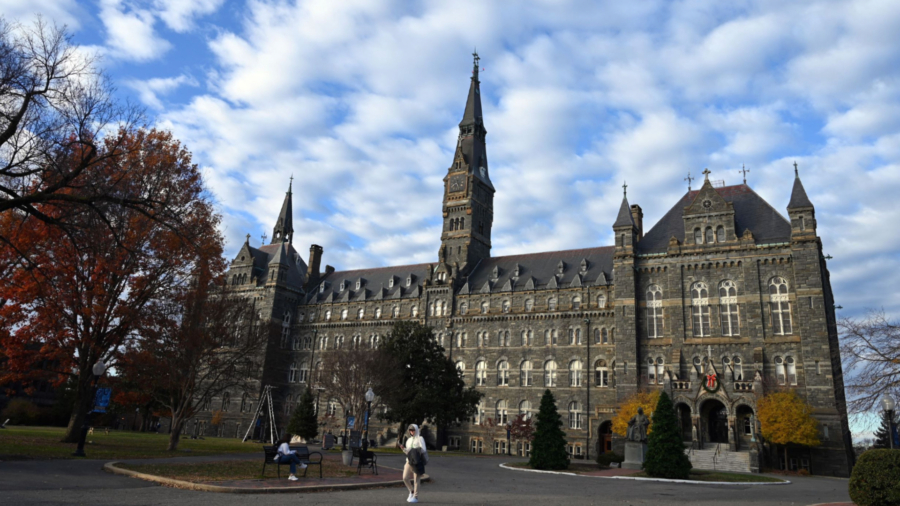It would be wrong to assume that after the Maryland Jesuits sold 272 slaves to Louisiana planters in 1838, slavery came to an end at Georgetown College.
It’s likely that hundreds of slaves worked at the college, and on the Jesuits’ six plantations in southern Maryland, who are not recorded as property of the religious order. Advocates for descendants, as well as historians of slavery, count such laborers as meriting the same status and recognition as those owned outright by the Maryland Jesuits. That calculus multiplies the number of descendants who have moral and financial claims against Georgetown University and other institutions that are investigating their historical links to slavery.
“We would be losing point of the story if Jesuit slaveholding, of slavery itself in this country, if we only focused on property relationships—who enslaved whom,” said Elsa Barraza Mendoza, an assistant professor of history at Middlebury College and the associate curator of the Georgetown Slavery Archive.
At least 60 slaves rented from local wealthy residents worked at the college, cooking, sewing, laundering, and cleaning for students and professors, she said. Families also donated slaves to Georgetown College for periods of time as a means of paying off students’ tuitions and other debts. Additionally, the religious order generated cashflow by leasing its Maryland farmland to tenant farmers who enlisted slaves to till the soil, tend to livestock, and perform other tasks, according to the report of Georgetown University’s Working Group on Slavery, Memory, and Reconciliation, issued in 2016.
“It did not end in 1838. It continued. But it continued through leasing,” Mendoza said. “There’s hundreds of people out there that we’re not talking about.”
The last enslaved worker recorded in Georgetown ledgers was Aaron Edmonson, a domestic servant who belonged to a Catholic woman named Ann Forrest Green and didn’t leave the campus until March 1862, nearly a quarter century after the infamous sale.
Another such enslaved person appears to have been a man named George Brown.
The Georgetown Memory Project, a private genealogical research organization founded in 2015 by a law school alum named Richard Cellini, first learned about Brown in 2016. A 1912 letter written by a Jesuit priest mentions that Brown, then in his 70s, requested permission to build a cabin in the woods in Charles County, on Jesuit land in southern Maryland, where Brown had hoped to live out his final days with his wife, “old Sarah.”
The priest’s letter provides key biographical details for genealogical researchers: Brown was born on Cedar Point Neck in Charles County; “here he served as the slave of a tenant called Savage”; and “hence he went to fight for the Union.”
This Jesuit record was sufficient to prove that a Brown was linked to a Jesuit-owned plantation in Charles County, M.D. But to locate living descendants, more information was needed.
George Brown’s military connection suggested a promising avenue of investigation: military records. The Georgetown Memory Project’s lead genealogist, Judy Riffel, located two Civil War pension applications (one dated 1887, the other dated 1916) filed by Brown and his wife, Sarah. These records provided further clues establishing Brown’s connection to the Jesuits, including an affidavit stating that he had been baptized by the Maryland Jesuits at St. Ignatius Catholic Church in Port Tobacco, in Charles County.
The pension application also showed that Brown had enlisted in the Union Army in January of 1864, served in the 19th Regiment of the U.S. Colored Troops, and was discharged three years later. Intriguing details, to be sure, but not enough for the Georgetown Memory Project to locate Brown’s living descendants.
Meanwhile, some 2,800 miles away in the Pacific Northwest, retired Department of the Navy civil servant John Dashiell Sr., a 69-year-old practicing Catholic originally from Charles County, Maryland, now living in Port Orchard, Washington, knew from family lore and his own genealogical research that he had a great-grandfather named George Brown in Charles County.
Researching online this year, Dashiell came across the Georgetown Memory Project’s home page. He emailed Cellini on May 9, asking for any additional archival records about his ancestors.
Dashiell’s email provided the final piece of the puzzle: a modern living descendant of George Brown who can be traced directly through sacramental records, U.S. Census entries, newspaper obituaries, military service records, and municipal birth and death certificates.
And because George Brown had at least nine children, there are potentially several hundred direct descendants–living and deceased—in Brown’s lineage.
On May 14, the Georgetown Memory Project notified Dashiell that he is a direct descendant of at least one of the individuals enslaved by the Maryland Mission of the Society of Jesus during the period 1634–1864.
In an official-sounding email, Cellini wrote: “Please accept my warmest and heartiest congratulations on this wonderful discovery.”
“The Georgetown Memory Project takes the considered view that slaves of tenants of the Maryland Jesuits were in essence slaves of the Maryland Jesuits,” Cellini’s email explained.
In a phone interview, Dashiell said he was dumbfounded by the revelation, and now feels entitled to the same recognition as any other descendant.
“This Jesuit piece is all new to us,” he said.
Dashiell also happens to have five grandchildren, aged 4 to 21, some of whom could theoretically apply to Georgetown under the preferential admissions program.
When asked what this discovery might mean for himself, his grandchildren, and future descendants, Dashiell faltered.
“I’m actually still digesting it,” he said. “It’s difficult at this time even just to process it.”
This article was written by John Murawski for RealClearInvestigations


